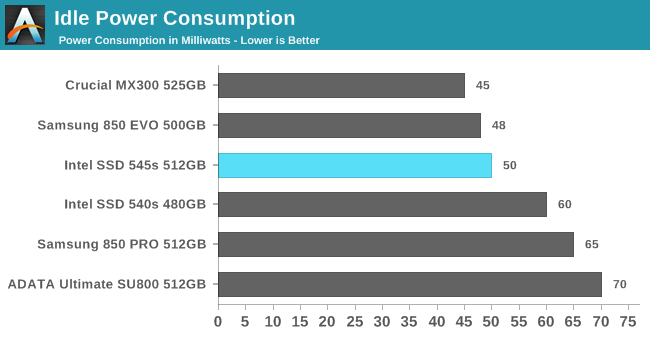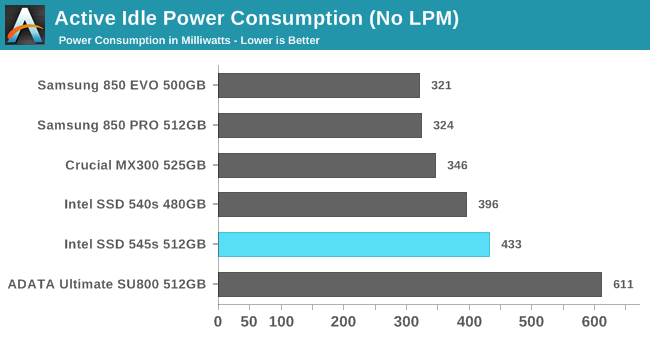The Intel SSD 545s (512GB) Review: 64-Layer 3D TLC NAND Hits Retail
by Billy Tallis on June 27, 2017 6:00 AM ESTIdle Power Consumption
Since the ATSB tests based on real-world usage cut idle times short to 25ms, their power consumption scores paint an inaccurate picture of the relative suitability of drives for mobile use. During real-world client use, a solid state drive will spend far more time idle than actively processing commands. Our SYSmark 2014 SE test covers this case, but because our testbed is a desktop system the SSD's contribution to the total power usage is small and hard to isolate from ordinary variation between test runs.
Our testbed doesn't support the deepest DevSlp power saving mode that SATA drives can implement, but we can measure the power usage in the intermediate slumber state where both the host and device ends of the SATA link enter a low-power state and the drive is free to engage its internal power savings measures.
We also report the drive's idle power consumption while the SATA link is active and not in any power saving state. Drives are required to be able to wake from the slumber state in under 10 milliseconds, but that still leaves plenty of room for them to add latency to a burst of I/O. Because of this, many desktops default to either not using SATA Aggressive Link Power Management (ALPM) at all or to only enable it partially without making use of the device-initiated power management (DIPM) capability. Additionally, SATA Hot-Swap is incompatible with the use of DIPM, so our SSD testbed usually has DIPM turned off during performance testing.

With SATA device-initiated link power management enabled, typical idle power consumption drops by a factor of ten, straining the resolution of our power meter. All of these SATA SSDs have very effective low-power idle states, but the 545s does show clear improvement over the 540s and Intel is now quite close to the Crucial MX300 and Samsung 850 EVO.

The Samsung drives have the best active idle power levels of this bunch, and the Crucial MX300 is not far behind. The Silicon Motion-based Intel 540s, 545s and ADATA SU800 are worst, though only the SU800 is trailing by a large margin. The 545s does draw more power than the 540s, which is not what we would expect from an updated controller design.
Idle Wake-Up Latency
Idle power consumption is not the only important metric of a SSD's power management capabilities. Devices cannot transition in and out of low-power states instantly. It takes time for components to switch back to higher clock speeds and resynchronize their data links to the rest of the system. At the extreme end, the several seconds it takes a hard drive to spin up obviously has a major impact on system responsiveness, and consequently operating systems have to be very conservative about when to put a hard drive to sleep, typically requiring at least several minutes of idle time during which the hard drive is wasting power.
The idle power transition time of solid state drives exists on a very different time scale, but it still matters to systems that are trying to minimize power consumption without sacrificing too much performance. When a SSD only takes a few milliseconds to enter and leave a power saving state, those power saving states can be used far more often, even during sustained interactive use like gaming. The cost of this approach is that far more I/O operations will incur the wake-up latency penalty.
Our equipment is not able to measure how long it takes a SSD to enter a low-power state; this would require very precise synchronization between the CPU and a high-resolution power meter. Timing how long a SSD takes to leave a low-power state is simple: perform one read operation every few seconds, and compare the latency with and without power management enabled. The difference, reported below, includes time taken to reestablish the SATA link and for the SSD to wake up, but does not include the time spent actively reading data from the flash memory since that will be the same whether or not the SSD had just been in a low-power state. Thus, this test is mostly a measure of the SSD controller and its firmware.

The Crucial MX300 has pretty good power consumption both at idle and under load, but its Marvell controller takes far longer to wake up from idle than its competition. At about 3.4ms, the MX300 is almost five times slower to wake up than the ADATA SU800, which has higher idle power consumption. The Intel 545s is a bit on the slow side at 1.4ms, about twice the wake-up latency of the ADATA SU800 or the Intel 540s. The total read latency for the 545s with power management enabled is just over 2.2ms.










74 Comments
View All Comments
t.s - Tuesday, June 27, 2017 - link
But of course, "If you want to play it safe", you could always go for the intel 545s /sDanNeely - Tuesday, June 27, 2017 - link
What happened to the performance consistency testing?Ryan Smith - Tuesday, June 27, 2017 - link
It's coming. But we had a rather short period of time to work on this."This launch comes at a bit of an awkward time for us. I've retired our aging 2015 SSD testbed and moved all the custom and homemade power measurement equipment over to a new system. Windows 8.1 is out and Windows 10 is in, and our IOmeter synthetic benchmarks are being replaced with Linux-based FIO tests that are more suited to modern TLC SSDs with SLC caches. For the past few weeks I've been focusing my efforts on validating the new testbed and test suite against NVMe SSDs, so the arrival at short notice of a new SATA SSD left me with no relevant comparison data."
Billy Tallis - Tuesday, June 27, 2017 - link
I didn't have time. I'll be doing it later this week. The new 2017 performance consistency test will be more thorough about testing different overprovisioning amounts, but that also makes it take longer to run.jjj - Tuesday, June 27, 2017 - link
The only interesting part is the rushed launch.Is anything much better about to hit the market or is Intel just trying to ship some more NAND in Q2 to "fix" the results? I suppose the Crucial BX300 is due in a couple of weeks, anything else?
Billy Tallis - Tuesday, June 27, 2017 - link
Intel wanted to beat WD and Toshiba to market with 64-layer 3D NAND. The Toshiba XG5 is already in the hands of OEMs but I'm not aware of any systems shipping with it yet. WD's 3D NAND SSDs are set to ship in Q3. They're all likely to have more powerful controllers than SM2259, and their charge trap flash cell architecture is closer to Samsung's V-NAND than IMFT 3D floating gate. Intel's right to want to be ahead of the others, but I think they could have spared another week.jjj - Tuesday, June 27, 2017 - link
Another week is no good, July 4th compromises the entire week.I was thinking more about value than perf when it comes to beating other new prods but chances are it is also about Q2 results, they want to boost the NAND segment a bit.
Do you have the Toshiba XG5 for review?
Billy Tallis - Tuesday, June 27, 2017 - link
Yes, the XG5 is what got bumped off the testbed to make room for these SATA drives. I'll be switching the testbed back to PCIe drives in a few days, after finishing up a few more tests on this batch of SATA drives.jjj - Tuesday, June 27, 2017 - link
Looking forward to that one.With the new tests, do you still look at mixed workloads?
Billy Tallis - Tuesday, June 27, 2017 - link
Yes. I'm not planning huge changes to the mixed workload tests, other than testing at 10% increments instead of 20%. My biggest goal with the new test suite is to have things more automated, which makes it easy to increase the level of detail in a lot of the tests (but it also makes it too easy to make the test suite take forever to run).